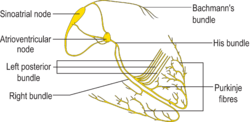- Heart block
-
Heart block Classification and external resources ICD-10 I44-I45 ICD-9 426.9 DiseasesDB 10477 MeSH D006327 A heart block is a disease in the electrical system of the heart. This is opposed to coronary artery disease, which is disease of the blood vessels of the heart. While coronary artery disease can cause angina (chest pain) or myocardial infarction (heart attack), heart block can cause lightheadedness, syncope (fainting), and palpitations.
Contents
Types of heart block
Electrical conduction system of the heart 
Isolated conduction system of the heart Latin systema conducens cordis A heart block can be a blockage at any level of the electrical conduction system of the heart (shown in the diagram on the right).
- Blocks that occur within the sinoatrial node (SA node) are described as SA nodal blocks.
- Blocks that occur within the atrioventricular node (AV node) are described as AV nodal blocks.
- Blocks that occur below the AV node are known as infra-Hisian blocks (named after the bundle of His).
- Blocks that occur within the left or right bundle branches are known as bundle branch blocks.
- Blocks that occur within the fascicles of the left bundle branch are known as hemiblocks.
Clinically speaking, most of the important heart blocks are AV nodal blocks and infra-Hisian blocks.
Types of SA nodal blocks
The SA nodal blocks rarely give symptoms. This is because if an individual had complete block at this level of the conduction system (which is uncommon), the secondary pacemaker of the heart would be at the AV node, which would fire at 40 to 60 beats a minute, which is enough to retain consciousness in the resting state.
Types of SA nodal blocks include:
- SA node Wenckebach (Mobitz I)[1]
- SA node Mobitz II
- SA node exit block
In addition to the above blocks, the SA node can be suppressed by any other arrhythmia that reaches it. This includes retrograde conduction from the ventricles, ectopic atrial beats, atrial fibrillation, and atrial flutter.
The difference between SA node block and SA node suppression is that in SA node block an electrical impulse is generated by the SA node that doesn't make the atria contract. In SA node suppression, on the other hand, the SA node doesn't generate an electrical impulse because it is reset by the electrical impulse that enters the SA node.
Types of AV nodal blocks
There are three basic types of AV nodal block:
- First degree AV block
- Second degree AV block
- Type I second degree AV block (Mobitz I) (also known as Wenckebach block)
- Type 2 second degree AV block (Mobitz II) - usually but not always below the AV node and therefore infraHisian - see below
- Third degree AV block (Complete heart block)
Types of infra-Hisian block
Infrahisian block describes block of the distal conduction system. Types of infrahisian block include:
- Type 2 second degree heart block (Mobitz II)
- Left bundle branch block
- Left anterior fascicular block
- Left posterior fascicular block
- Right bundle branch block
Of these types of infrahisian block, Mobitz II heart block is considered most important because of the possible progression to complete heart block.
References
- ^ Hurst's The Heart, 10th Edition. McGraw-Hill Professional Publishing. November, 2000. Figure 24–60b. ISBN 0071356959.
Categories:
Wikimedia Foundation. 2010.
